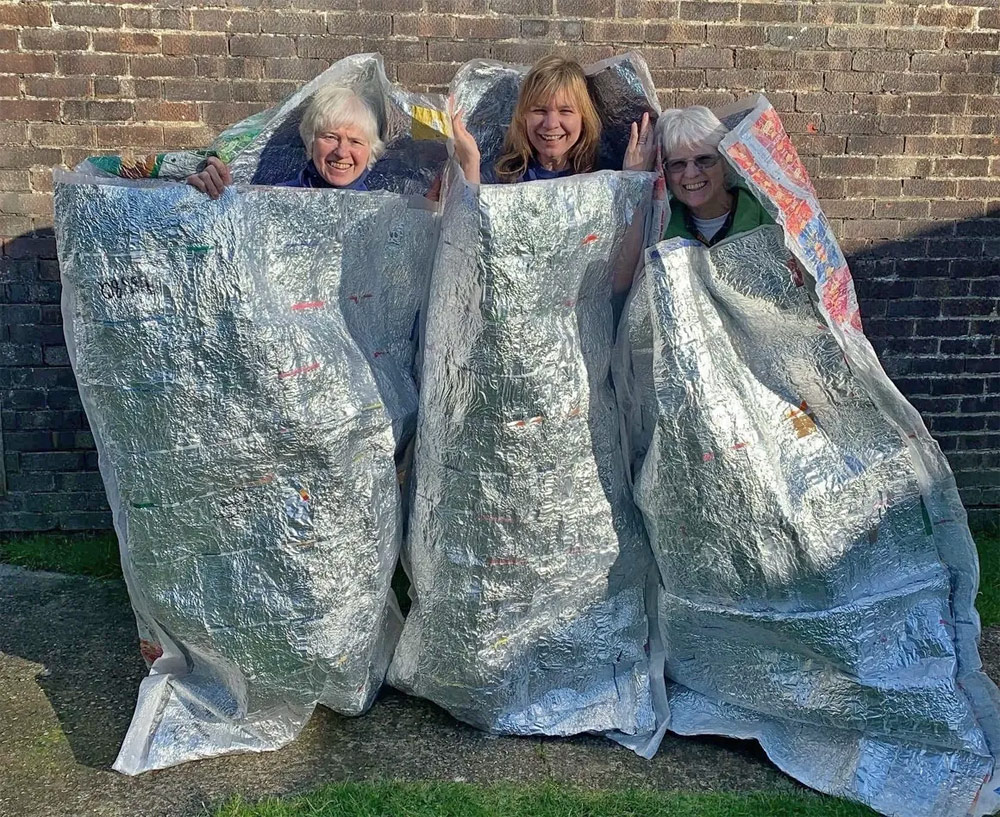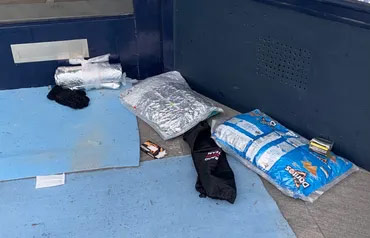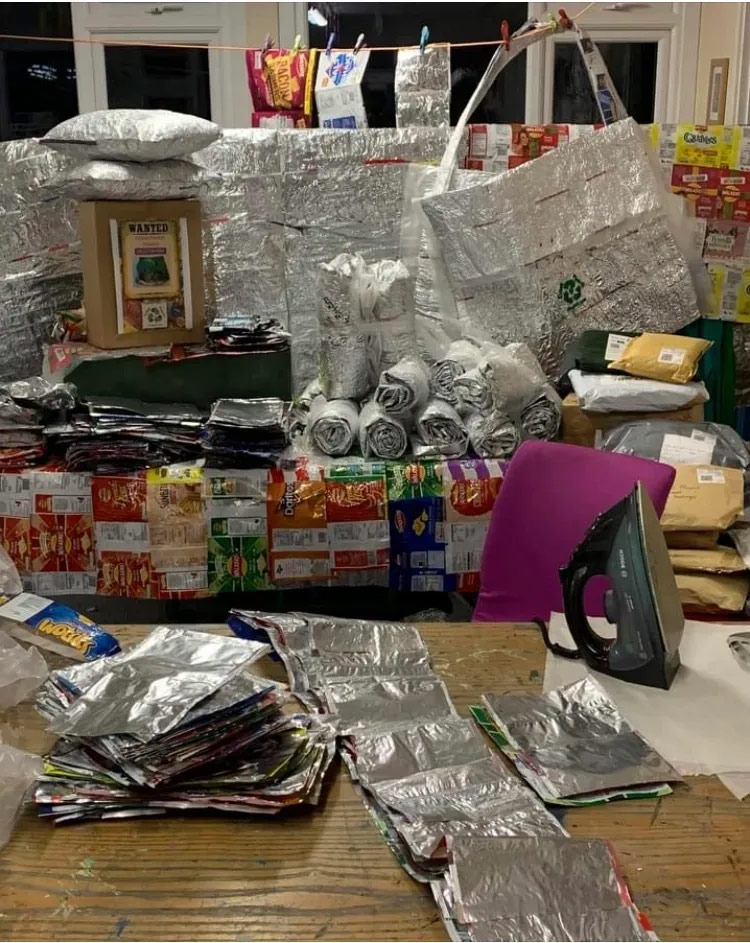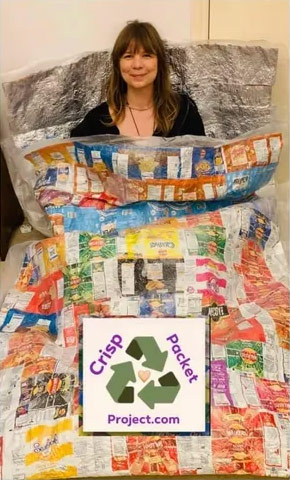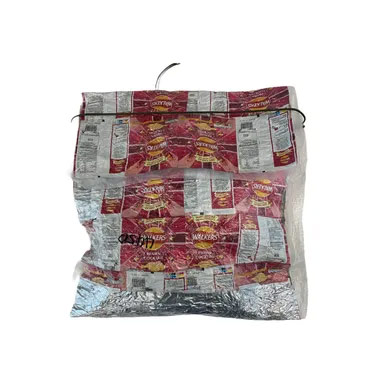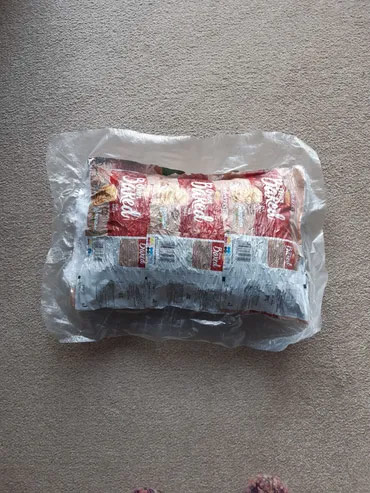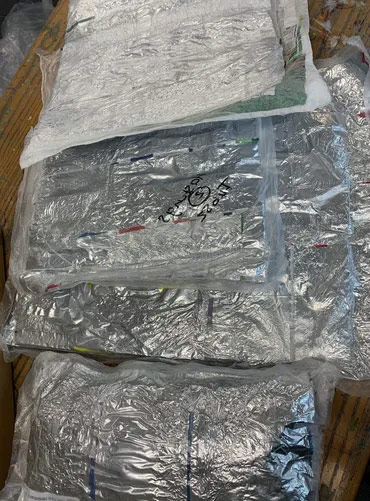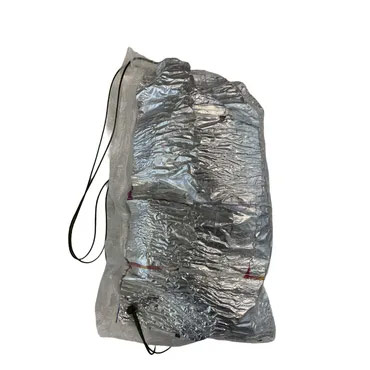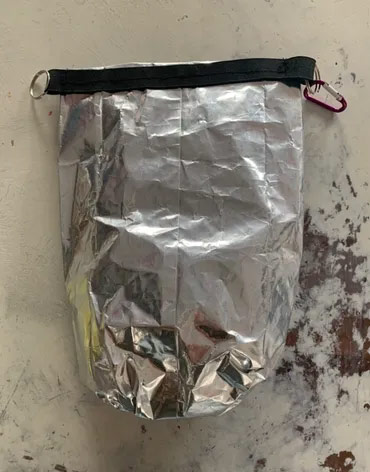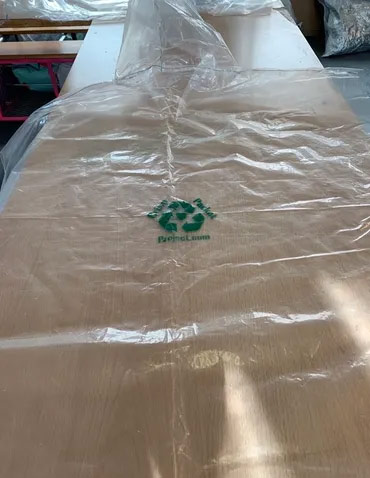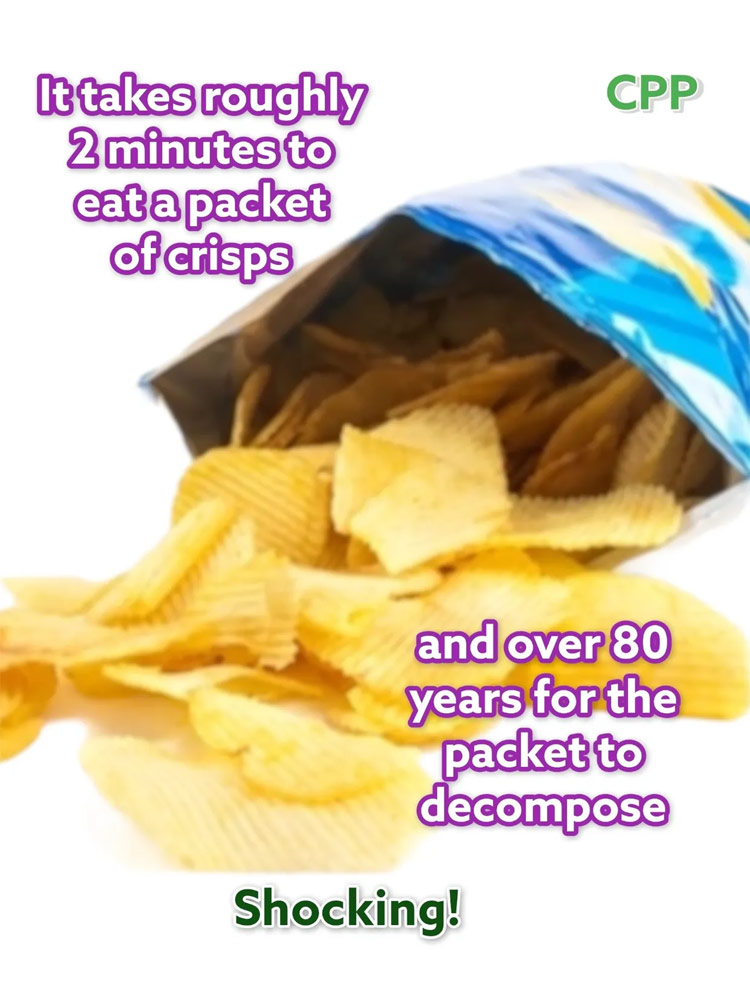
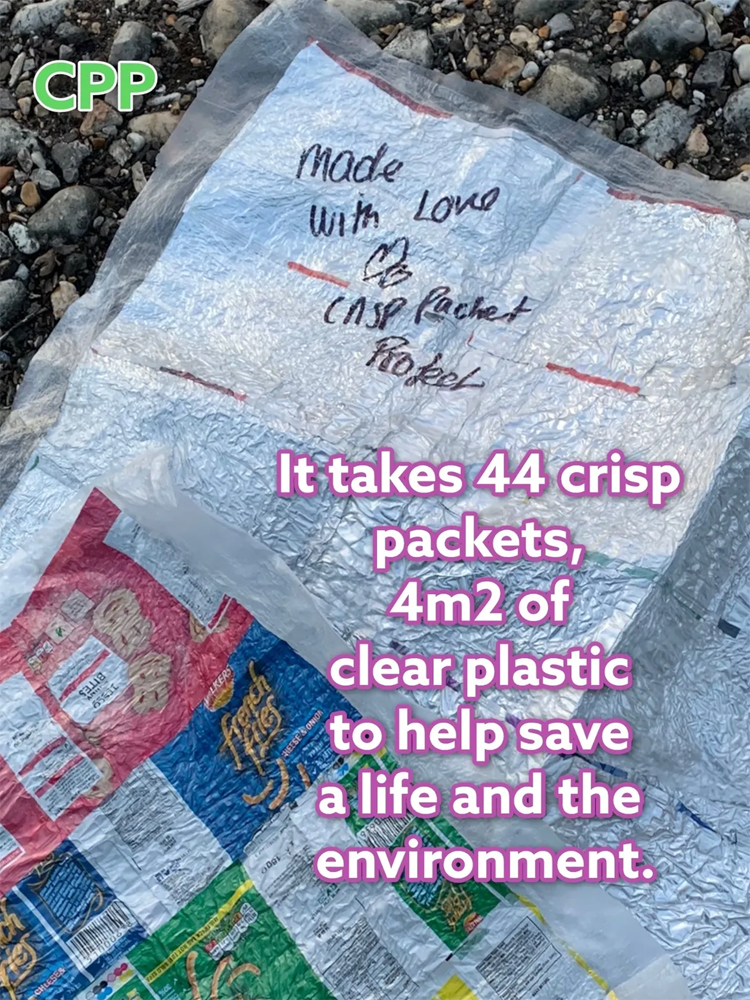
How to cut open and prepare your crisp packets & what packets are best?
For best results use the ✅ ones. Only use silver lining packets and not too thick. Any size packets will do, and multi packs.
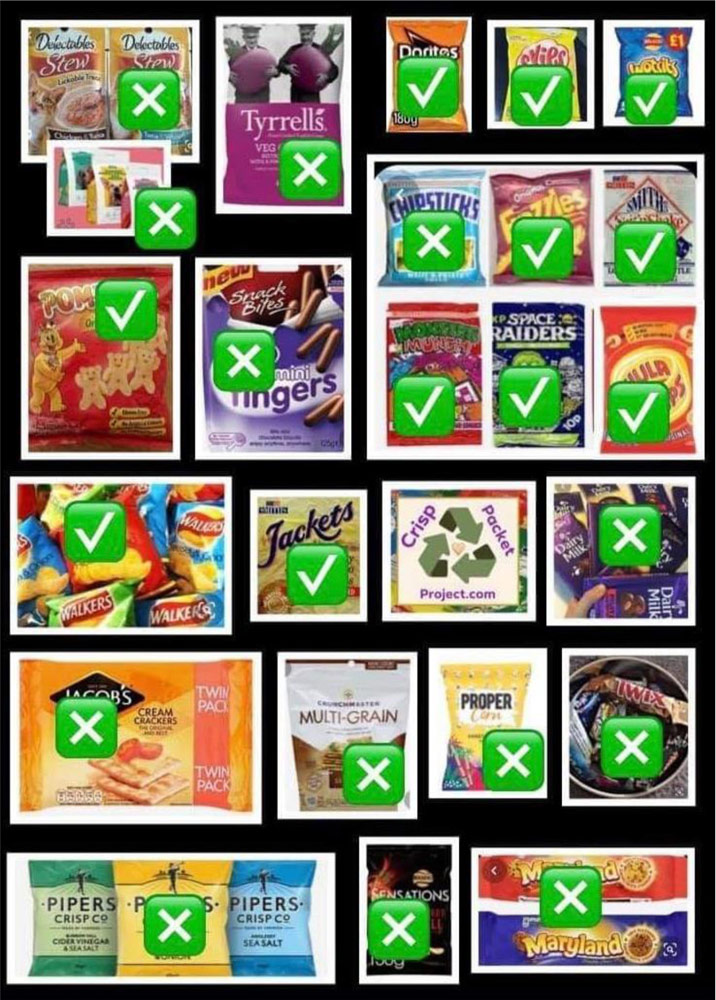
To save time you can put crisp packets through the washing machine on a low temperature very quick wash and towel dry.
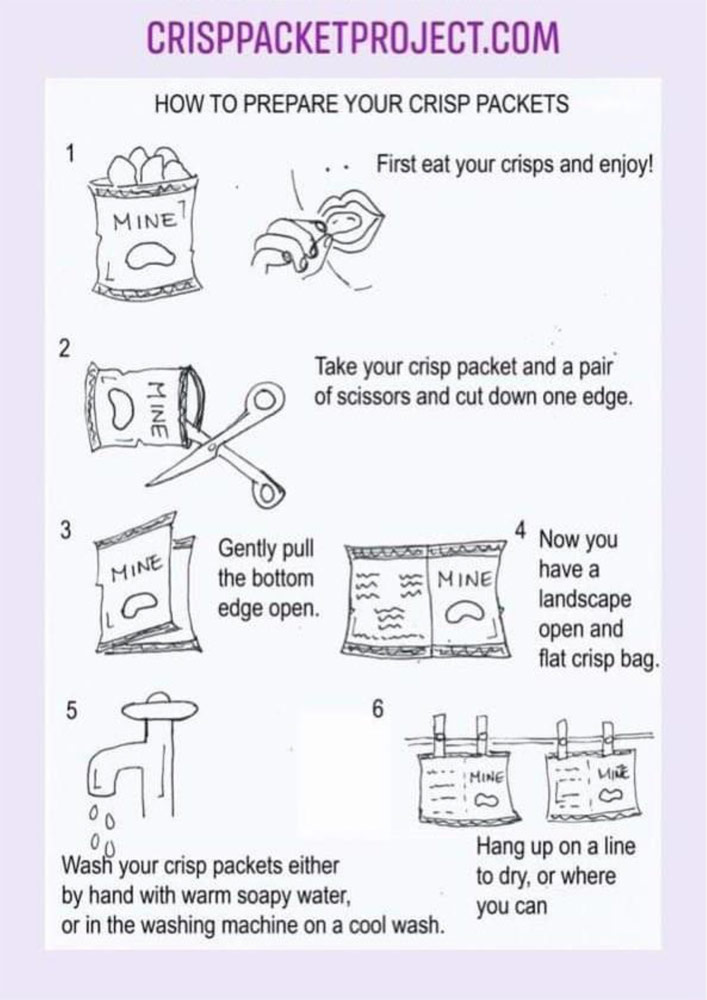
Finding and using the right plastic
This is for the outer protective layer, fusing the crisp packets together to make the blanket waterproof and durable. You will need the plastic to make a full blanket. You will
also need a well ventilated room e.g. garage, or open all windows in room and wear half face mask (A2-P3)
Which plastic?
- Only use land fill ‘non recyclable’ plastics, so we can give new life to one use plastics!
- The plastic you use should not be too thick and not too thin, for example, cling film is too thin and thick plastic that comes on sofas or furniture is too thick. Your plastic should not be any thinner than a bread bag but can be slightly thicker. Too thick will take longer to fuse, and the blanket won’t be able to roll or fold for carrying.
- I find the best source of plastic comes from the bulk packaging found at supermarkets – the bags toilet and kitchen rolls come in to the stores.
- Needs to be clear plastic. Coloured plastic will not fuse well together and will cover the silver reflecting the body heat.
- Small bits of plastic works just as well and these can be fused together, it will just take more time.
Places to look: supermarkets, clothes shops/warehouses, furniture shops, dry cleaners
Plastic examples: outer layer of toilet roll and kitchen roll, dry cleaner’s bag, clothes bags
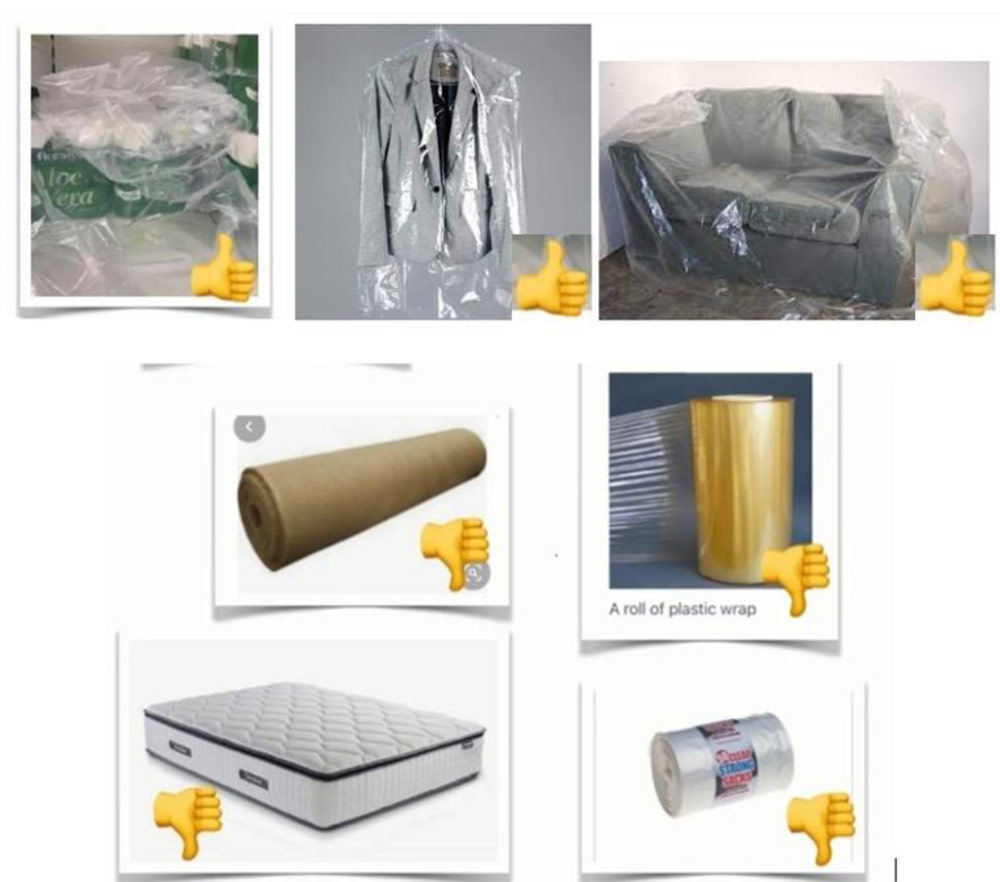
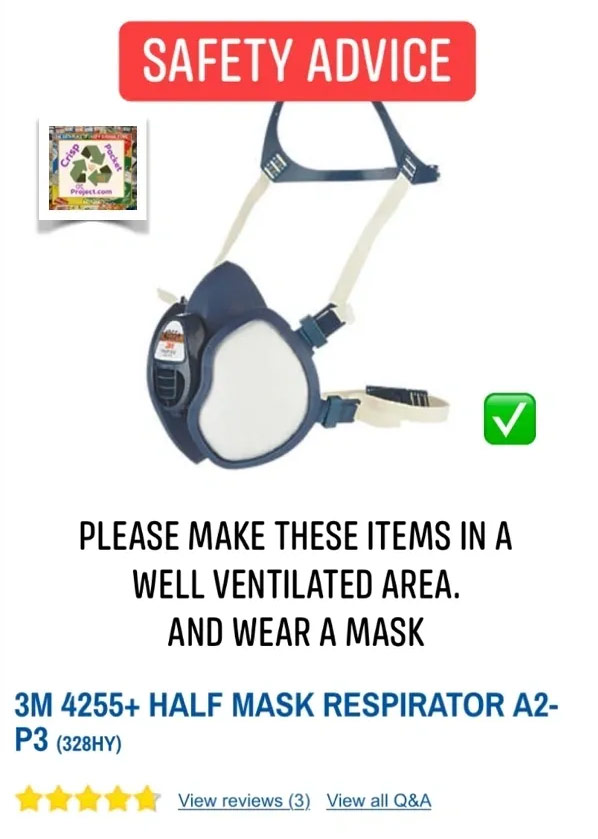
Crisp packet survival sheet
This is a sheet of fused crisp packets. First fused into a grid then fused on both sides in clear landfill plastic bag waste. This is put on both sides like a big sandwich. Our less fortunate community like these as they can be used as a blanket to keep warm – the silver lining in the crisp packet reflects body heat back into the body. They also use these as ground sheets, shelter from the rain and to sit and sleep on top, t o stop the damp getting to them.
All children must be supervised at all times
You will need:
- an iron
- a sheet of baking paper
- 44 regular crisp packets, washed and cut open landscape way
- 110cm by 210cm x 2 of plastic clear bags. These do not have to be one sheet – just enough to cover the measurement of all the bags that will be fused together.
Fuse the crisp packets together – 4 x 11 strips of crisp packets joined up into a grid
Get 4 crisp packets and start by fusing landscaped way side by side overlapping them by 1c. Your iron shouldn’t be too hot – start on a cool setting and adjust the heat until the crisp packets fuse together. I’ve found that each iron is different and some crisp packets fuse differently. You will soon find out if they aren’t fusing, so turn your iron up. If they are fusing too fast just turn your iron down. make sure you use the one second rule! Don’t let your iron touch the crisp packet directly – use a big enough piece of baking paper.
Keep your crisp packets as straight as possible.
Fuse your strips in a straight line keeping one good straight edge. When you have your 11 strips of 4 packets, start to join each one from the centre point making sure each end lines up. Keep joining each strip on to each other until you have a big grid.
Fusing the plastic layers
When fusing this plastic be sure to use the baking paper on top to stop it sticking to your iron.
The first side is just to get it on so don’t worry if it look a mess. All will fuse pushing any air out as you go.
Start in the middle of the top of your sheet, making sure you have about 4cm at the top, away from your crisp packet then fuse from the middle top, away from your crisp packet then fuse from the middle top outwards left, then right, all the way down. Then turn over and repeat.
When doing the second side you can spend more time fusing every bit. Then when you turn it over you just need to go over the bits that have been missed. Make sure your sandwich is fused all the way around the outside.
Don’t worry if you tip your iron or there is a hole in your bag, just cut a patch of plastic and iron on.
Trim the edges
Leave about 2cm fused all the way around the outside so that the crisp packets are well sealed together. Cut a border about 2cm all the way around.
Notes
- You do not need to use regular sizes but this just helps when you’re first starting our and to teach people.
- As long as your grid is not too thick and is roughly 100cm by 200cm, fused nicely so the plastic lays flat on the crisp packet, this will work well.
- When making your survival sheets and blankets take your time to make it well so that it lasts on the streets.
- Also attach a tag on every item under the plastic or stick a sticker on it saying; Not Fire Resistant. This video shows it takes some time to light and it’s not explosive but as a precaution we must write something. I have not heard of any injuries or incidents since using these on the streets.
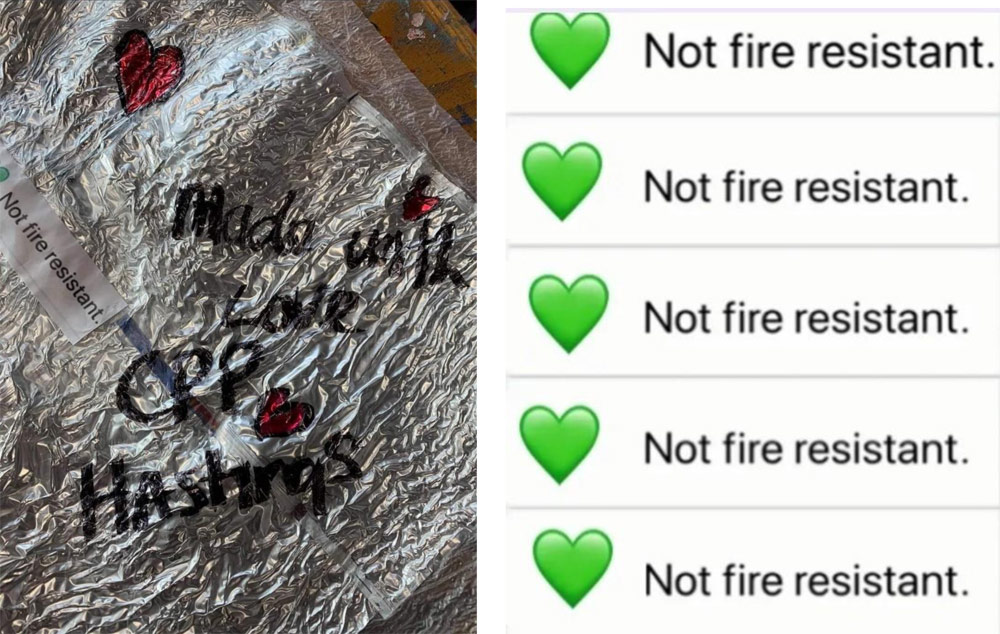
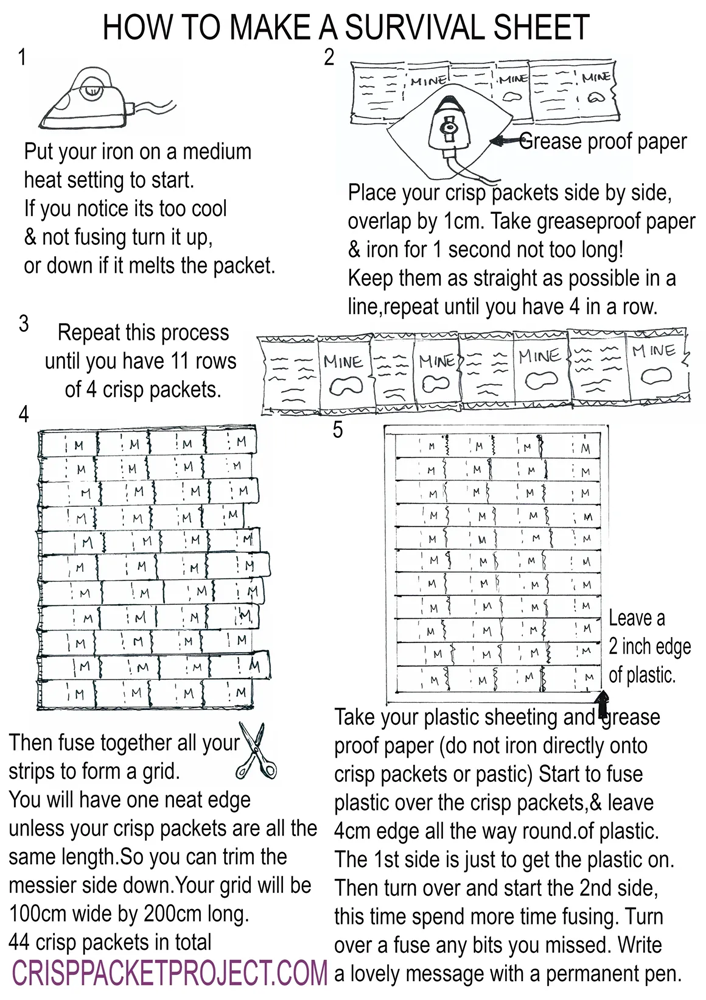
Fold and add a strap
Write a nice message on it with a permanent marker and fold and roll up. You can use a bit of string or fuse some plastic to make a tie or thicker plastic.
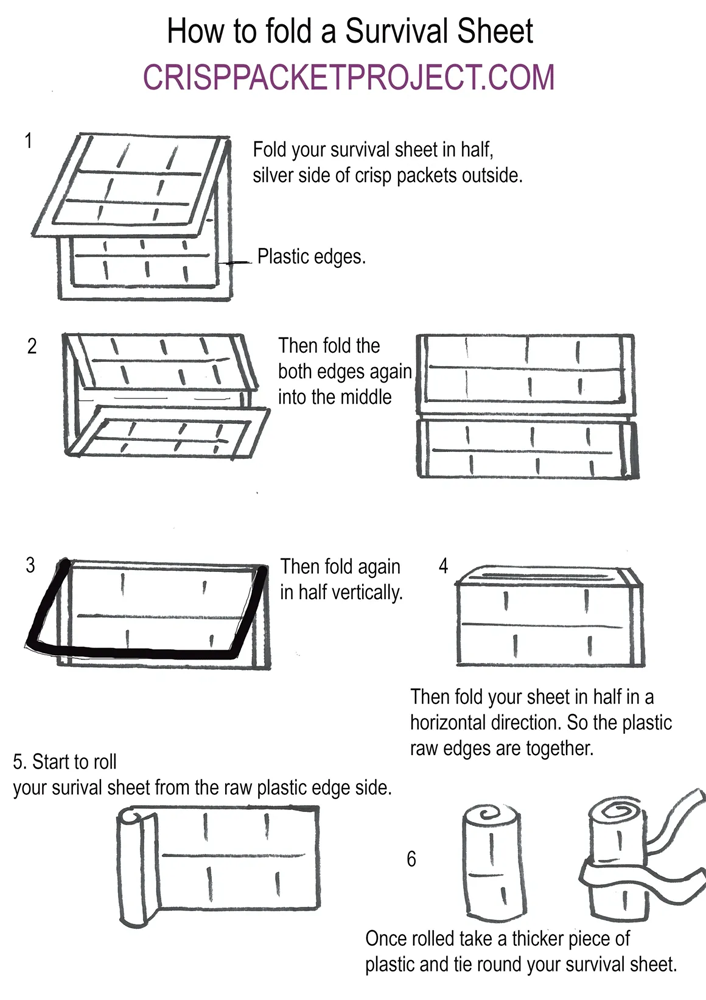
Crisp Packet survival blanket
The same method for making a sheet (above) but requires a grid of 5 x 15 and uses 75 packets.
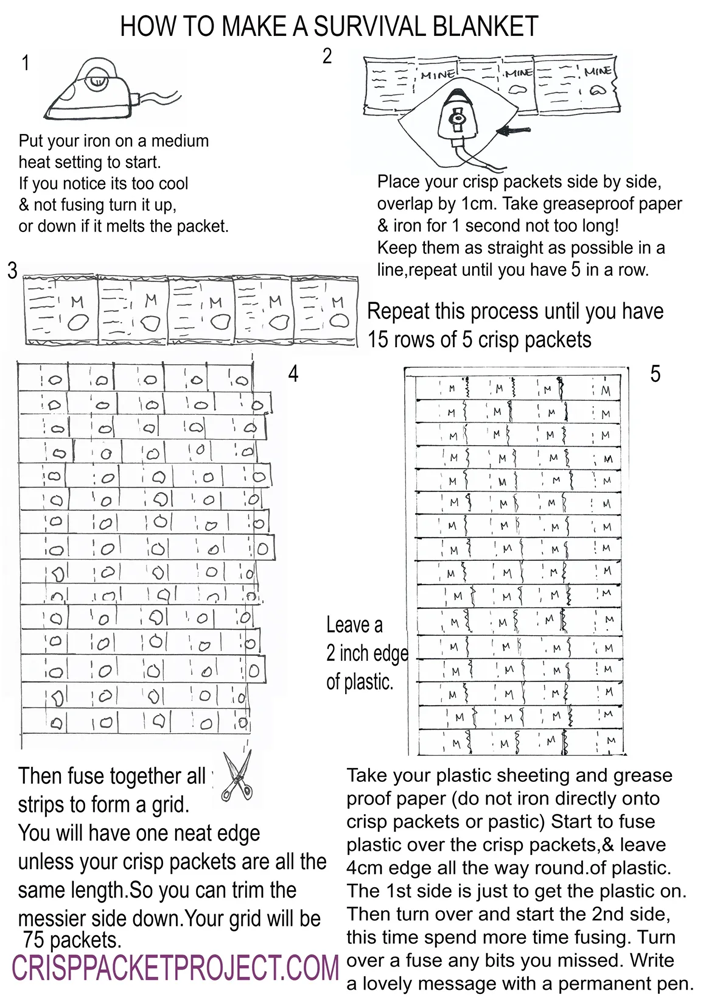
How to make crisp packet a bivi bag
You will need
- 75 regular packets for each panel. 150 packets in total. 15 rows of 5 for the front and the same for the back. Each grid will be roughly 210cm ling and 125cm wide
- You will need a hole punch, soldering iron or a hot nail/knife. This is for the air vents at the final stage.
- A pillow
5×5 regular crisp packets to make a grid You will need 3 of these put together to make one front side and the same for the back.
Leave an overlay of 2 inches of plastic at the top, 4 inches at the bottom and 8-10 inches each side for the front. On the front panel fuse a 4 inch window of plastic each side.
Join the feet together by overlaying the crisp packets by 1 and 1/2 bags. Make sure its crisp packet side onto silver side. Line up the panels straight, if one is slightly wider even the sides up.
With a hole punch make 3 holes each side for air vents from the middle upwards.

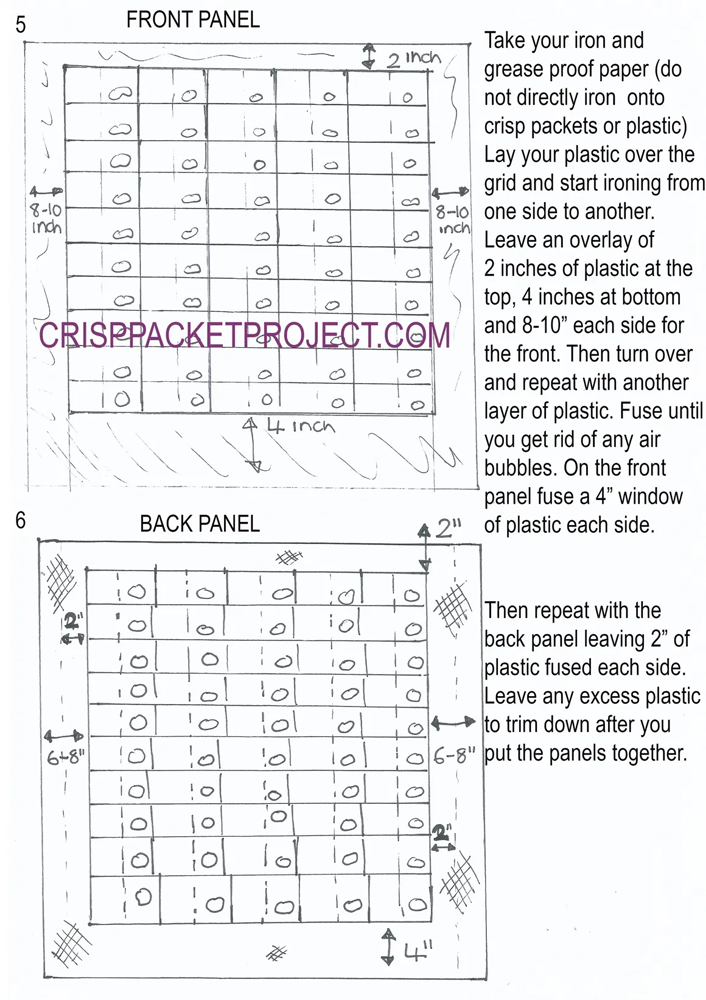
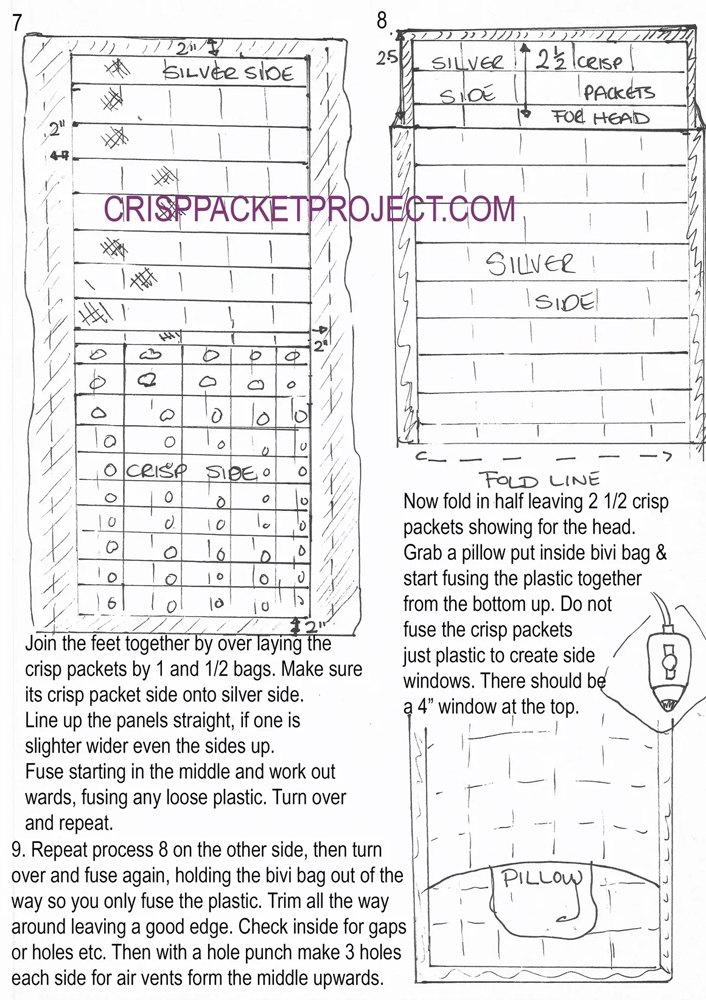
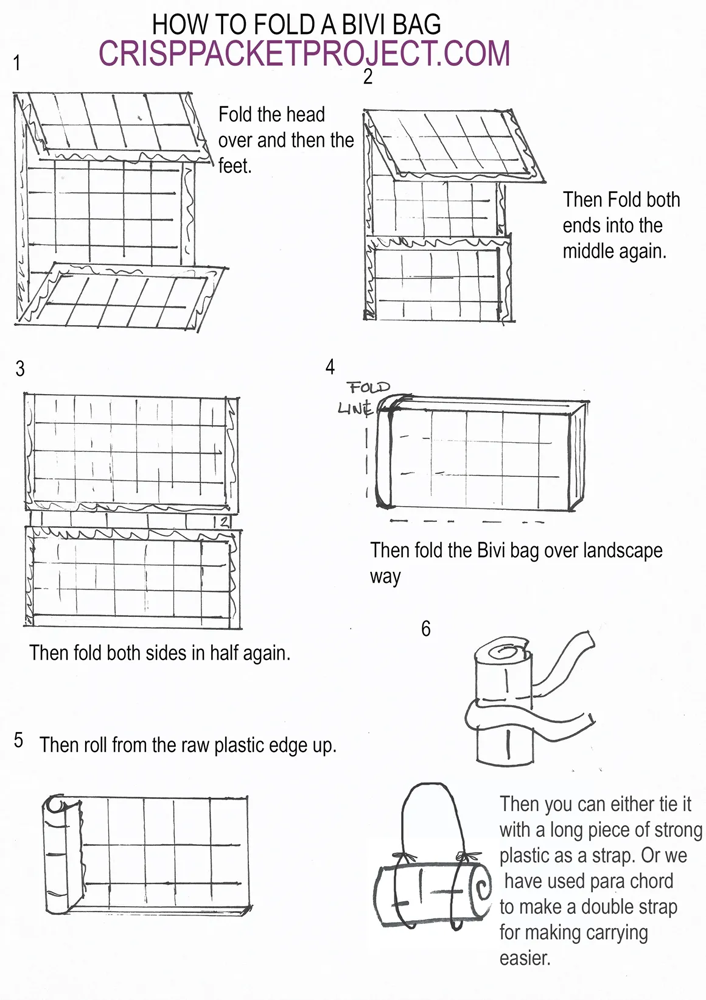
Questions and Answers
Q. How many crisp packet does it take to make a CPP survival sheet?
A. It takes 44 regular size crisp packets or any size crisp packet to make a grid of 100cm by 200cm or a blanket 75 crisp packets.
Q. How many crisp packets dose it take to make a CPP Bivi bag ?
A. It takes 150 crisp packets or 110cm by 210cm x2 and no grater than 125cm by 225 x 2 panels. Our New Bivi bag is now 135 crisp packets with one large 10 inch window.
Q. What plastic should I use ?
A. All plastic should be clear plastic not any colours this is very important as colours have more toxins in it.
Your plastic should be as thick as a plastic bread bag and not any thinner slightly thicker is ok. You will find if your plastic is too thick it will be too bulky to fold up and will take longer to fuse. Some thicker plastic can be used for handles and making ponchos if not too thick.
Cling film and wrap is too thin. And plastic that beds and carpets come in is to thick to fuse. Please make sure it is a fuse not a melt and you don’t touch the iron with your plastic – use a big sheet of baking paper. Use a well ventilated area and a mask is recommended. If you do get plastic on your iron remove by scraping on the side of an old table while hot.
Q. How long does a survival sheet take to make start to finish?
A. A survival sheet takes about 1 and half hours and a Bivi bag roughly 3 and a half hours
Q. What are the best crisp packets to use?
A.The best crisp packets to use are most walkers brands or anything that is fairly soft. most leading supper-market brands .
Q. What are the worst crisp packets to use?
A. Sensations and lentil curls are some of the worst packets. anything thick in paint and dark or light in colour. These heat up differently. And once the plastic goes on can leave holes. I would not use Chocolate packets – again the plastic doesn’t fuse as well .
Q. What equipment do you need?
A. Your need an iron, baking paper, scissors and a tape measure. A mask or a well ventilated room to work in.
Q. Can I make these for my local community?
A. Yes you can make this to help your less fortunate community. Either hand them out or get in touch with your community out reach team .
Q. How do you open a crisp packet?
A.To prepare your crisp packet one end will be open already then open the bottom then cut one side or the middle of the back panel. Then you have a crisp packet opened landscape way. Then wash.
Q. How do you wash a crisp packet?
A. You can either wash them in warm soapy water then hang out to dry or towel dry. Or put them in your washing machine cut open on a quick wash in a pillow case tied up not more than 30 degrees. Or place them cut in your dishwasher. All towel dry or hang out.
Q. How long do these items last?
A. This really depends on how well you make them and how well your less fortunate friend looks after it. People I know still have my first ones. They are very strong. I have had a couple come back to re fix when they have torn them on trees and nails . I give them a new one and peach the old one back up to use again . Some of our less fortunate community pass them on once they are not homeless anymore.
Q. How do they work?
A. They work because the crisp packet silver side reflects your heat back into your body the strong materials in the crisp packet plus the plastic fused on to the packets makes this a supple strong long lasting material .
Q. Do the homeless like them?
A. Our less fortunate community only have praise for these items they have given me a lot of advice over the year and they say this is an amazing bit of kit. One chap said this was the best thing that helped him living on the streets for 6 months.
Q. How do I distribute them?
A. You can find a local out reach charity maybe a church or if you see someone living on the streets ask if they would like your item. These items are good to keep in your car in an emergency also. or you can post to us to then send out.
We hand them out to Survival The Streets Uk Charity. I go out with them on there evening feeds Also there fantastic team that has them on there 0800 number so anyone in the area of Hastings can ring and they will deliver. We now send out to different counties.
Q. How can I help?
A. You can by collecting or making these life saving items in your local community.
Q. Where can I get plastic from?
A. You can get the right clear plastic from most supermarkets, warehouses clothes shops.
Q. Can I open a CPP area Facebook group?
A. You can open a CPP Area group if you have made one crisp packet survival sheet . You can use our crisp packet project group logo and all our information. Please do get in touch if you would like to do this so we can mentor and guide you with our information. We have a CPP Organisers group on Facebook to help you and we all help each other.
Q. Can I open my own none CPP group ?
A. You can open your own group. Get cracking on making these life saving items. Please do not use our photos. Sadly people have been making money through using our photos which is a real shame. As we didn’t mind at first but as this has happened I have to say no. If you are wanting to use our information to make money please do think again. This project is to help people and to give one use plastics a new life. if you become a CPP AREA GROUP ON Facebook YOU CAN USE ALL OUR information.
Q. How can our school organisation get involved?
A. Your school can get involved by having a collection box, washing and cutting your packets either then sending them to one off our groups or why not get making these life saving lives. Maybe your school would like a zoom demonstration from the founder of this project Pen Huston.
Q. What are your CPP survival items?
A.
- CPP survival sheet / blanket
- CPP Bivi sleeping bag
- Poncho made from landfill waste plastic
- Pouches made from coffee bags
- Plastic weave torso mat
- CPP cushions
- CPP sack bags \draw string
- CPP wash kit bag
- CPP torso mat /dog bed
Q. How long has your project been running?
A. This project has been running since November 2019
Q. Is this an on going project?
A. This is an on going project until there are no more homeless needing our items.
Q. Is this a charity?
This is not a registered charity , we are a CIC, community interest company, non profit organisation.
Q. Do we make money?
A. We receive small donations which help pay towards electric, equipment, rent and postage costs.
Q. How many volunteers help run the CPP?
A. We have roughly 15 Hastings CPP volunteers we are a very productive group .
Q. How do I book a zoom?
A. Please look at our information on how to book a zoom then send us your information on booking form / confirmation on payment. Then we will send your zoom details and confirmation.
Q. Will you be going on tour again?
A. At this time of uncertainty I think not. But for now we are concentrating on Zoom demonstration to keep spreading and teaching how to make your your own survival items. We have just started holding cpp workshops in the East Sussex area.
Q. How many CPP area groups are there?
A. We have 38 CPP area groups and growing every day
How many crisp packets does it take to make?
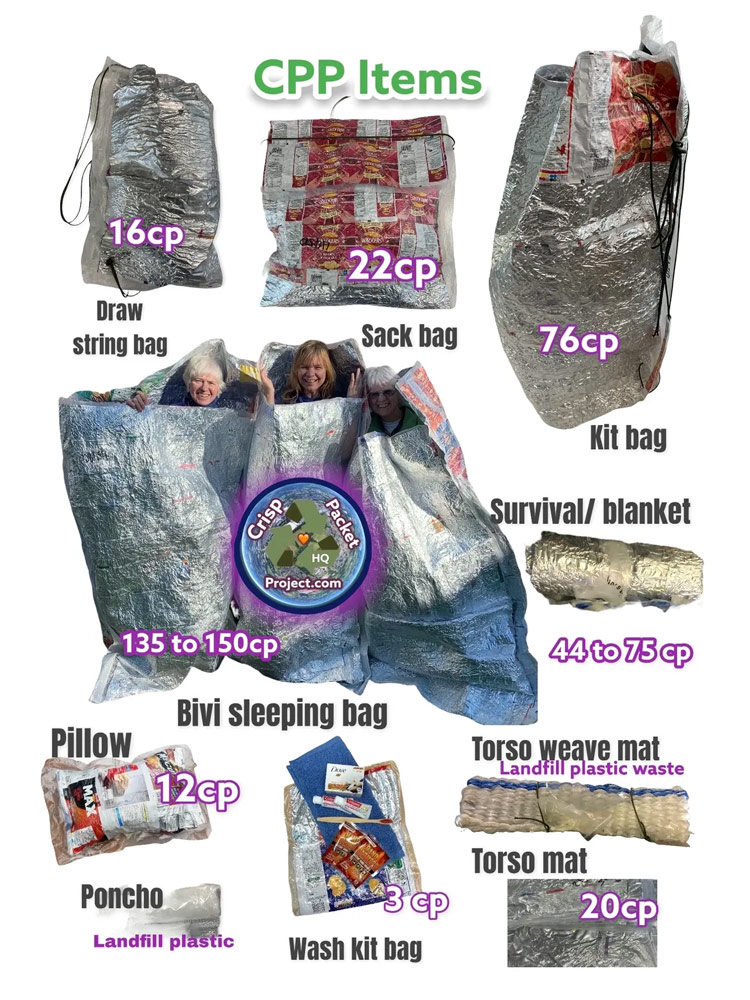
Crisp Packet Project, UK
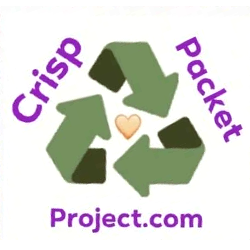
PROFILE
The crisp packet project was founded in 2019 by Pen Huston, the aim was to find a purpose for one use plastics.
The crisp packet project makes survival kits and products for the most vulnerable people living on the street.
Main Research Source
The Crisp Packet Project has a series of videos covering all the steps.
I found the written instructions difficult to follow but will update the main points once I’ve both watched the videos and had a go.


